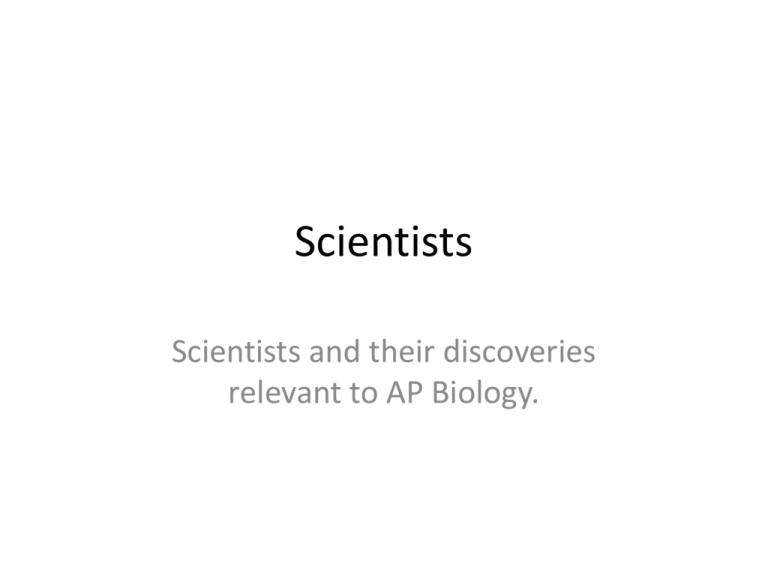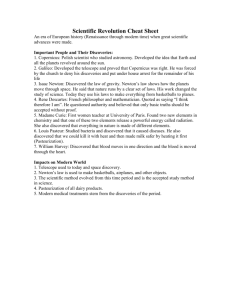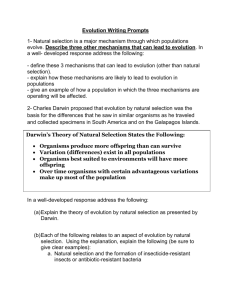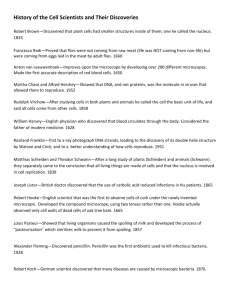Scientist Powerpoint - Warren County Schools
advertisement

Scientists Scientists and their discoveries relevant to AP Biology. Scientist Name (Ch. X) • Discovery • Picture Scientist Name (Ch. X) • Discovery • Picture Scientist Name (Ch. X) • Discovery • Picture Charles Darwin • Discovered the Theory of natural selection. Gregor Mendel • Idea that organisms transmit genes to offspring. Thomas Hunt Morgan (Ch.16.1) • Showed genes are located along chromosomes. Marinus Beijerinck (Ch. 19) • Discovered the infectious particle of tobacco mosaic disease. Wendell Stanley(Ch. 19) • Crystallized and isolated infectious particle of tobacco mosaic disease. Hans Christian Gram(Ch. 27) • Discovered and developed gram straining. Lawrence Henderson(Ch. 3) • Highlights the importance of water to life. Life adapts to its environment through natural selection. Christian Doppler (Ch. 14) • Explained natural phenomena by math to train students. Chris Langdon (Ch. 3) • Used Biosphere -2 center to test the effects of verifying concentration of CO3 2- on the rate of calcification in the coral reef. Gregor Mendel (Ch. 14) • Discovered basic principles of heredity by breeding garden pea plants in experiments, developed a theory of inheritance several decades before chromosomes were observed under microscopes and the significance of their behaviors were understood. Hermann Kolber (Ch. 4) • Made the organic compound acetic acid from inorganic substances that could be prepared directly from pure substances. Franklin Stahl (Chapter 16.2) • Stahl conducted the famous Meselson-Stahl experiment showing that DNA is replicated by a semi conservative mechanism, meaning that each strand of the DNA serves as a template for production of a new strand. Reiji Okazaki (Chapter 16.2) • Okazaki fragments were originally discovered in 1966 by Kiwako Sakabe, and Reiji Okazaki during their research on DNA replication of Escherichia coli. Carolus Linnaeus (Chapter 39.1) • He discovered that plants opened their flowers at certain parts of the day, and these patterns can be used as a 12 hour clock face. Dmitri Ivanovsky (Chapter 19.1) • He was the first man to discover viruses (1892) and thus one of the founders of virology. Alfred Hershey (Ch. 16.1) • In 1952 he discovered that DNA is the genetic material of phage. Martha Chase (Ch. 16.1) • In 1952 she discovered that DNA is the genetic material of phage. Erwin Chargaff (Ch. 16.1) • In 1950 he discovered that the base composition of DNA varies based on species. Mendel Gregor • Discovered heritable factors Frederick Griffith • Studied a bacterium that causes pneumonia Oswald Avery, Maclyn McCarty, Colin MacLeod • Discovered the tranforming agent of DNA Alfred Russel Wallace(Ch.22) • Developed a hypothesis of natural selection similar to Darwin’s. Candace Pert(Ch.48) • Discovered endorphins as an outcome of their research on the biochemistry of behavior. Earl W. Sutherland (Ch.24) • Discovered that epinephrine stimulates the breakdown of glycogen within the liver cells and skeletal muscle cells. Solomon Snyder(Ch.48) • Provided the first demonstration that opiate receptors exist. Hans Krebs (Ch. 9.3) • Largely responsible for working out the pathway to discover the Krebs Cycle Peter Mitchell • Awarded Nobel Prize in 1978 for originally proposing the chemiosmotic model (Ch. 9.4) Rudolf Virchow (Ch. 12) • He’s a German Physician, known for his theory: “Where a cell exists, there must have been a preexisting cell, just as the animal arises only from an animal and the plant only from a plant.” Cornelis Bernardus Van Niel • Van Niel hypothesized that plants split H2O as a source of electrons from hydrogen atoms, releasing O2 as a byproduct. 20 years later it was confirmed. Melvin Calvin • Discovered the second stage of photosynthesis, Calvin cycle. This stage incorporates CO2 into organic molecules. Theodor W. Engelmann • Used bacteria to measure rates of photosynthesis in filamentous algae. He was first to demonstrate the action spectrum. Friedrich Wohler (Ch. 4) • Made Urea from organic materials Oliver Smithies (Ch. 13) • Used Mice To Study Human Genetic Disorders. Aristotle (Ch. 13) • Noticed life-forms can be arranged on a scale in order of complexity. Carolus Linnaeus (Ch. 13) • Created Genus- species naming system. Justin Scheer (Ch. 7) • Screened nearly 8,000 compounds for their ability to bind to a possible allosteric binding site and inhibit the enzymes activity; his results turned out to support him. . Martin Evans (Ch. 21) • Used molecular and genetic techniques to generate mice with any given gene disabled in order to study the role of the gene. Mario Capecchi (Ch. 21) • Used molecular and genetic techniques to generate mice with any given gene disabled in order to study the role of the gene. Fredrick Sanger (Ch. 21) • Came up with the Deoxyribonucleic Chain Termination Method, which determines the complete nucleotide sequence of a gene. Richard Lenski (Ch. 27) Discovered and documented adaptive evolution Hardy-Weinberg (Ch. 22) Came up with the solution for the question of how genetic diversity is maintained in a population. Charles Darwin (Ch. 22) Came up with the theory of evolution that all species of life came from one source. Robert Brown (Ch. 22 • Helped discover that cells have a nucleus. Charles Darwin • Discoveries: - Darwin recognized that a population evolves through the differential reproductive success of its variant members. Gregor Mendel • Discoveries: - Mendel published a theory of inheritance that helps explain genetic variation, but his discoveries had no impact on biologists until 1900 Edwin Southern • Discoveries: - Made up the method Sothern Blotting, which combines gel electrophoresis and nuclei acid hybridization, allowing detecting of bands that include parts of the B-globin gene.







